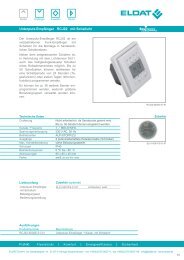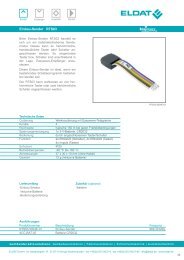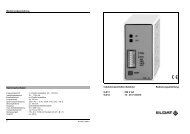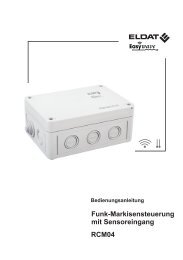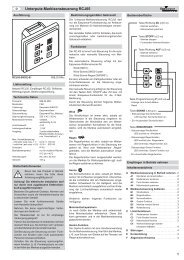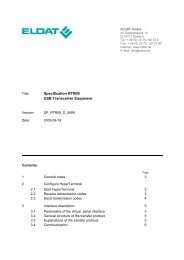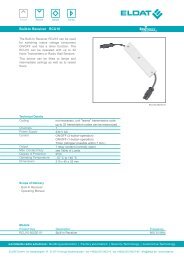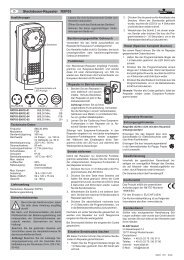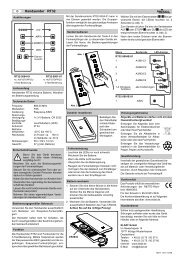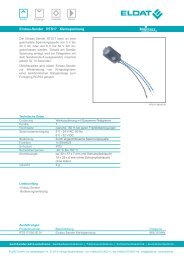Specification of RTRM08 Transceiver Module Easywave I2C - ELDAT
Specification of RTRM08 Transceiver Module Easywave I2C - ELDAT
Specification of RTRM08 Transceiver Module Easywave I2C - ELDAT
Create successful ePaper yourself
Turn your PDF publications into a flip-book with our unique Google optimized e-Paper software.
<strong>Specification</strong><br />
Index 1.01<br />
Project No.<br />
RF-Products, Controller <strong>RTRM08</strong> <strong>Transceiver</strong> <strong>Module</strong> Easw I 2 C Page 5<br />
Development<br />
Production S. Schreiber 2007-08-24<br />
Pin number Signal name Signal direction Description<br />
1 VCC - Power supply (2.1 V ...5.25 V).<br />
2 GND - Ground.<br />
3 / RESET in Reset. Active low.<br />
4 SDA bidirectional (open-drain) I 2 C serial data I/O.<br />
5 SCL bidirectional (open-drain) I 2 C synchronous serial clock I/O.<br />
6 / REQ out (open-drain) Request output. It indicates whether an<br />
<strong>Easywave</strong> telegram could be received and<br />
whether a received <strong>Easywave</strong> telegram is<br />
over. Active low.<br />
7 - 12 (NC) - Pins are not allowed to connect to any circuit.<br />
There are options for the antenna available, for example, coaxial connectors or an antenna via the module's<br />
connector. Please contact <strong>ELDAT</strong>.<br />
2.2 Power up and Reset<br />
The module's / RESET signal is not allowed to be high until the power supply is in the operational range. The<br />
module is in inactive state subsequently; it can be controlled via the I 2 C-bus.<br />
The / REQ output <strong>of</strong> the module goes to (active) low until the module's rx mode is altered.<br />
The module also can be reset at any time independent from its former state by asserting the / RESET signal.<br />
2.3 I 2 C-bus<br />
The SCL and the SDA pin are the I 2 C-bus as defined in the “THE I 2 C-BUS SPECIFICATION VERSION 2.1“<br />
(January 2000), document order number 9398 393 40011 by Philips.<br />
A short discussion <strong>of</strong> the I 2 C-bus follows in this section. If both this specification <strong>of</strong> the <strong>RTRM08</strong> transceiver<br />
module and the referred “THE I 2 C-BUS SPECIFICATION VERSION 2.1“ document define a specific detail,<br />
the specification <strong>of</strong> the <strong>RTRM08</strong> transceiver module has informational characteristics only.<br />
The I 2 C clock rate <strong>of</strong> the transceiver module can be up to 100 kHz (Standard Mode).<br />
Signal Lines <strong>of</strong> the I 2 C-bus<br />
The I 2 C-bus is a 2-wire bus; it has a bidirectional serial clock line SCL and a bidirectional serial data line SDA.<br />
Both SCL and SDA are combined inputs and open-drain outputs. There must be one pullup-resistor on each<br />
<strong>of</strong> the SCL and the SDA line. The <strong>RTRM08</strong> transceiver module I 2 C PHY does not include these pullupresistors.<br />
A device connected to a bus can be either a master or a slave. A master device is able to acquire the I 2 C-bus<br />
and initiate a transfer from (read) or to (write) a specified slave. The master generates the clock on the SCL<br />
line in order to transfer the serial data bits. The slave can slow down the transfer if it can't transmit or receive<br />
data bytes fast enough (clock stretching, see below). The master has to terminate the transfer and release<br />
the I 2 C-bus either successfully or due to a fail.<br />
The SDA line is driven by the device which transmits data bits: it is either a master or a slave.<br />
One or more master devices can be connected to the I 2 C-bus. This specification covers examples with one<br />
master only, but the transceiver module also works on I 2 C-busses with more than one master (multi-master).<br />
7007



